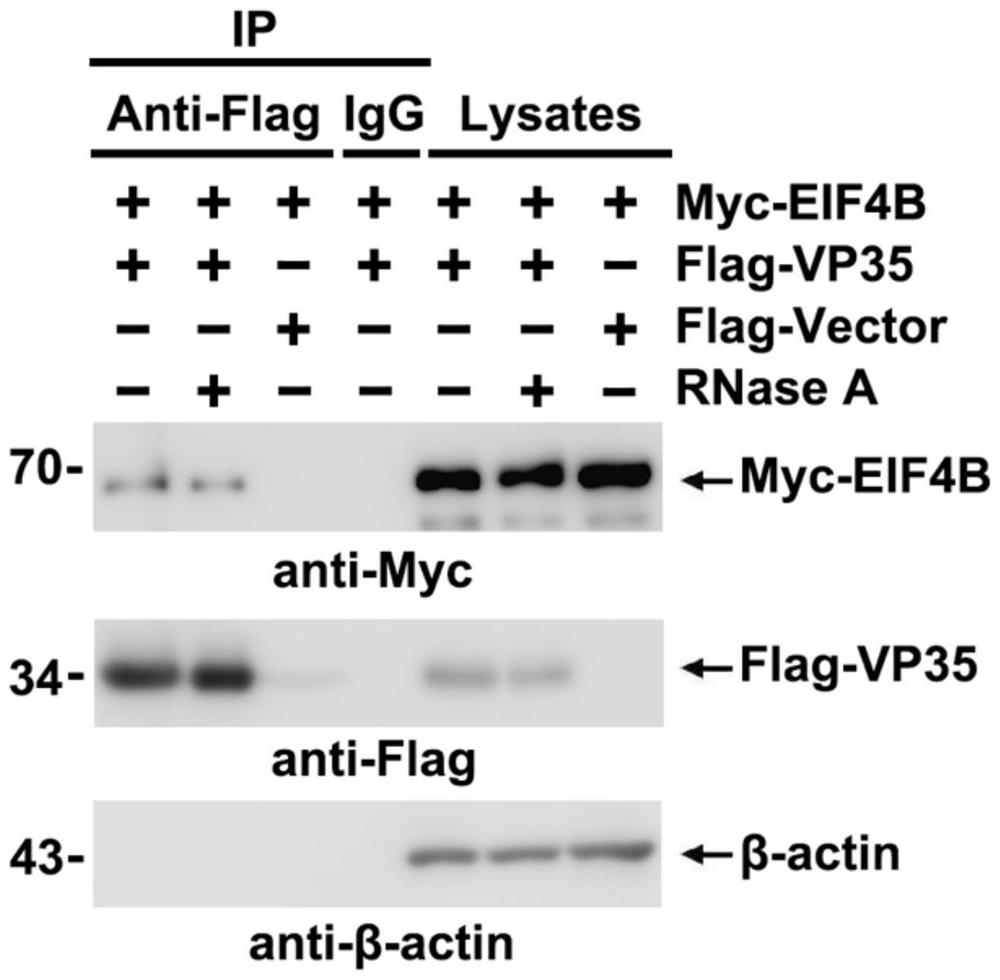Application of eukaryotic translation initiation factor EIF4B as Ebola virus disease treatment target
A technology of translation initiation factor and Ebola virus, which is applied in the field of biomedicine to achieve the effect of reducing replication
- Summary
- Abstract
- Description
- Claims
- Application Information
AI Technical Summary
Problems solved by technology
Method used
Image
Examples
Embodiment 1
[0026] In this example, co-immunoprecipitation was used to confirm the interaction between EIF4B and VP35. VP35 is an important structural protein in the replication process of Ebola virus.
[0027] The specific experimental method is as follows:
[0028] (1) Construction of expression vectors of Myc-EIF4B and Flag-VP35. The build method is:
[0029] Taking the construction of Myc-EIF4B expression plasmid as an example, the relevant experimental steps are described. As follows: search for the EIF4B gene sequence on the database NCBI, use primer5 to design EIF4B amplification primers, which are synthesized by Beijing Nuosai Genome Research Center Co., Ltd.; PCR amplifies the target fragment, use EcoRI and XhoI for double digestion at 37°C, and agar The digested products were recovered after gel electrophoresis. Use T4 ligase to react it with PCMV-Myc vector at 16°C for more than 2 hours, transform DH5α competent cells, and spread the bacterial solution evenly on the solid L...
Embodiment 2
[0034] In this example, immunoblotting was used to screen the siRNA with the highest efficiency of knocking down EIF4B, the method is as follows:
[0035] (1) Two pairs of 0.15nmol siRNA were transfected into 293 cells (six-well plate) using TransIT X2 transfection reagent, and the cells were harvested after 72 hours. Aspirate the medium first, collect and resuspend the cells in pre-cooled 1×PBS, wash 3 times, and discard the supernatant completely. After adding cell lysate (Tris-HCl 50mM pH8.0, NaCl 150mM, 1% NP40, protease inhibitor 1 piece / 50ml), place on ice for 30min, centrifuge at 12000rpm at 4°C for 10min, pipette 60μl supernatant to clean 1.5ml EP Add 15 μl of 5×SDS-PAGE loading buffer into the tube, bathe in boiling water for 10 minutes, centrifuge at 4°C and 8000 rpm for 3 minutes, take 10 μl of the supernatant for polyacrylamide gel electrophoresis (SDS-PAGE), after electrophoresis at 80V for 30 minutes, put Adjust the voltage to 120V until bromophenol blue migrate...
Embodiment 3
[0049] In this example, the Ebola minimal genome was used to detect the effect of EIF4B siRNA on virus replication. In this example, the Ebola minimal genome is used to simulate the life cycle of Ebola virus under biosafety level 2 conditions. In this system, a 4-cistronic minigenome (minigenome, MG) was formed by linking the renilla luciferin reporter gene (RLUC) with the virus genome lacking NP, VP35, and L. When MG and NP, VP35, L and T7 polymerase are co-transferred into 293 cells, the virus can replicate and produce virus particles containing MG (without self-replicating ability). When the virus replicates, RLUC is also expressed. Therefore, the virus replication can be evaluated by detecting the value of RLUC with a dual-luciferase detection kit. That is, the higher the RLUC value, the higher the virus replication level.
PUM
 Login to View More
Login to View More Abstract
Description
Claims
Application Information
 Login to View More
Login to View More - R&D
- Intellectual Property
- Life Sciences
- Materials
- Tech Scout
- Unparalleled Data Quality
- Higher Quality Content
- 60% Fewer Hallucinations
Browse by: Latest US Patents, China's latest patents, Technical Efficacy Thesaurus, Application Domain, Technology Topic, Popular Technical Reports.
© 2025 PatSnap. All rights reserved.Legal|Privacy policy|Modern Slavery Act Transparency Statement|Sitemap|About US| Contact US: help@patsnap.com



